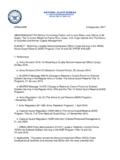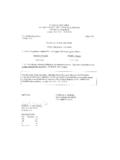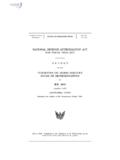Transcription of A HISTORY OF THE NCO
1 A HISTORY OF THE army MUSEUM OF THENONCOMMISSIONED OFFICERW ritten ARMSE dited byMelissa CooperMarch army SERGEANTS MAJOR ACADEMYA US army Museum of the Noncommissioned Officer PublicationThis publication is a work of the Government as defined in Title 17, Code, Section 101. As such, it is in the public domain, and under the provisions of Title 17, US Code, Section 105, it may not be 1989, the US army Sergeants Major Academy published a work entitled A Short HISTORY of the NCO. This work provided the army noncommissioned officer and researchers of NCO HISTORY with a concise, readable overview of NCO HISTORY . It contained accounts and actions of NCOs throughout HISTORY and brief descriptions of the evolution of the NCO Corps. A Short HISTORY of the NCO went through many printings and received wide dissemination throughout the NCO Corps.
2 It can be found on the NCO Museum s website and several other places on the internet. In the years that followed, America has called upon NCOs to fight in a number of conflicts. Three chapters have been added to cover the period from 1989 to the present: Protection of National Interest, Desert Storm (1st Iraqi War), and Islamic Fundamentalism and the 2nd Iraqi War. This allows the reader to catch up on the HISTORY of the noncommissioned officer. However, A HISTORY of the NCO seeks to accomplish more than to catch up on the years of NCO HISTORY that has followed since the printing of A Short HISTORY of the NCO. Additional stories on historical NCOs like Sergeant Patrick Gass, Sergeant Alexander Kenaday, Color Sergeant Peter Welsh, etc.
3 Provide for a greater in-depth coverage of NCO presentation of this HISTORY follows a chronological order, based upon a variety of works listed at the end of the paper with the author. Throughout the work, sources are listed in the following manner: (von Steubeun). Two unpublished works in the Museum s reference files greatly helped; these works are the two Fisher Manuscripts noted in the Sources Consulted. Several oral histories and other works drawn from the Museum s archives give depth and a source of primary resources to the work. Arms Curator army Museum of the Noncommissioned OfficerTable of ContentsIntroduction 1 American Revolution 2 The Basis of NCO Duties Sergeant William BrownWar of 1812 4 Kentucky VolunteersDaquin s BattalionExpansion Westward 7 Patrick GassFur Factories1820 s & 1830 s 9 The First Chevron SystemAbstract of Infantry TacticsDaily LifeIndian RemovalImmigrationMexican-American War 12 The NCO SwordChevron system of 1847 Sergeant Alexander Kenaday1850 s 14 Percival LoweChevron system of 1854 Civil War 18 Standard BearerCorporal William HeatlyColor Sergeant Peter WelshMassachusetts 54thEarly Schools for NCOsIndian Wars 22 Sergeant Charles L.
4 ThomasSergeant George JordanNCO Wives1880 s & 1890 s 24 Sergeant John T. O KeefeThe Greely ExpeditionSoldier s HandbookSpanish-American War 26 The 4th Illinois, National GuardTaking SantiagoPhilippine InsurrectionModernization 30 Growth of TechnologyNoncommissioned Officers ManualTurning the Chevron Point UpWorld War I 31 NCO SchoolThe TrenchesCorporal Harold TurnerCorporal Alvin YorkSFC Charles AndersonPlatoon Sergeant and FireteamBetween the Wars 32 The Great Grade Reorganization of 1920 ReductionsTechniciansFirst Sergeants HandbookWorld War II 33 Isolated in the PhilippinesTwelve-man Infantry SquadBasic TrainingStaff Sergeant Charles W. SheaSergeant Harrison SummersWomen in the ArmyPost-World World War II 37 Career Guidance PlanNCO EducationKoreaThe 1958 Grade ReorganizationVietnam 39 Noncommissioned Officer Candidate CourseSergeant First Class Eugene AshleyFirst Sergeant James A.
5 DiamondThe SMAThe CSM ProgramNCO Education 41 NCOES and NCO EducationSergeants Major AcademyThe Growth of NCO EducationProtection of National Interest 43 Operation Urgent FuryOperation Just CauseKosovo-Sgt Christine RobertsDesert Storm 44 Sgt Barbra BatesSSG Michael DudaIslamic Fundamentalist and Second Iraqi War 44 Afghanistan-SSG Raymond DePouliOperation Iraqi FreedomSFC Paul Ray SmithSgt. Lindsey JamesSSG Nein and Sgt. Leigh Ann HesterConclusion 51 Sources Consulted 52 List of IllustrationsAssault on Redoubt #10 3 Daquin s Battalion & Choctaws 6 NCO Sword 12 Assault on Churubusco 13 Percival Lowe, B Company, 2nd Dragoons, 1852 15 First Sergeant James Wright 20 Ordnance Sergeant, 25th Infantry, 1885 23 Sergeant Major and Wife 24 Corporal Paul Janest, Signal Corps 35 Enlisted women of the Signal Corps 37 Company K, 35th RTC, 25th Division 38 SMA William Wooldridge 41 SFC Paul Ray Smith, 2nd Iraqi War 47 Searching Streets in Baghdad 49 This work is dedicated.
6 To the young, who leave home in search of adventure and find themselves warriors in a distant HISTORY of the United States army and of the noncommissioned officer began in 1775 with the birth of the Continental army . The American noncommissioned officer did not copy the British. He, like the American army itself, blended traditions of the French, British, and Prussian armies into a uniquely American institution. As the years progressed, the American political system, disdain for the aristocracy, social attitudes, and the vast westward expanses further removed the army noncommissioned officer from his European counterparts and created a truly American noncommissioned RevolutionIn the early days of the American Revolution, little standardization of noncommissioned officer numbers or duties existed.
7 During 1776, General George Washington standardized the infantry regiment at eight companies and one Headquarters Company. The Headquarters Company or regimental NCOs included one sergeant major, a quartermaster sergeant, a drum major, and a fife major. Each company had four sergeants, four corporals, two drummers or fifers, and seventy-six the long, hard winter of 1778 at Valley Forge, Inspector General Friedrich von Steuben standardized NCO duties and responsibilities in his Regulations for the Order and Discipline of the Troops of the United States (printed in 1779). Among other things this work (commonly called the Blue Book) set down the duties and responsibilities for corporals, sergeants, first sergeants, and sergeants major, which were the NCO ranks of the period.
8 It also emphasized the importance of selecting quality enlisted men for NCO positions. (*von Steuben) This work served for 30 years as the primary regulations for the duties for the noncommissioned officer, as set forth by von Steuben were:The Sergeant Major served as the assistant to the regimental adjutant. He kept rosters, formed details, and handled matters concerning the interior management and discipline of the regiment. (*von Steuben)The Quartermaster Sergeant assisted the regimental quartermaster, whose duties he assumed during the quartermaster s absence. He also supervised the proper loading and transport of the regiment s baggage when on march. (*von Steuben)The First Sergeant enforced discipline and encouraged duty among troops, maintained the duty roster, made the morning report to the company commander, and kept the company descriptive book.
9 This document listed the name, age, height, place of birth, and prior occupation of every enlisted man in the unit. (*von Steuben)Sergeants and corporals were expected to instruct recruits in all matters of military training, including the order of their behavior in regard to neatness and sanitation. Outbreaks and disturbances were to be punished. Listings of the sick were forwarded to the First battle, NCOs were to close the gaps occasioned by casualties and encourage the men to silence and to fire rapidly and true. (*von Steuben)The development of a strong NCO Corps helped sustain the Continental army through severe hardships to final victory. Von Steuben s regulations established the centerpiece for NCO duties and responsibilities from 1778 to the present the early stages of the American Revolution, the typical Continental army NCO wore an epaulet to signify his rank.
10 Corporals wore green and 2sergeants and wore red epaulets. After 1779, sergeants and above wore two epaulets, while corporals retained a single epaulet. (*Emmerson) The epaulets were color-coded according to branch: white for the infantry and dragoons and yellow for artillery and the American Revolution to World War II, the noncommissioned officer received his promotion from the regimental commander. Soldiers often spent their entire career in one regiment. If a man transferred from one regiment to the next, he did not take his rank with him. No noncommissioned officer transferred in grade from one regiment to another without the permission of the General in Chief of the army ; this rarely occurred. Without permanent army -wide promotions on individuals, stripes stayed with the NCOs received special recognition for acts of heroism during the American Revolution.












